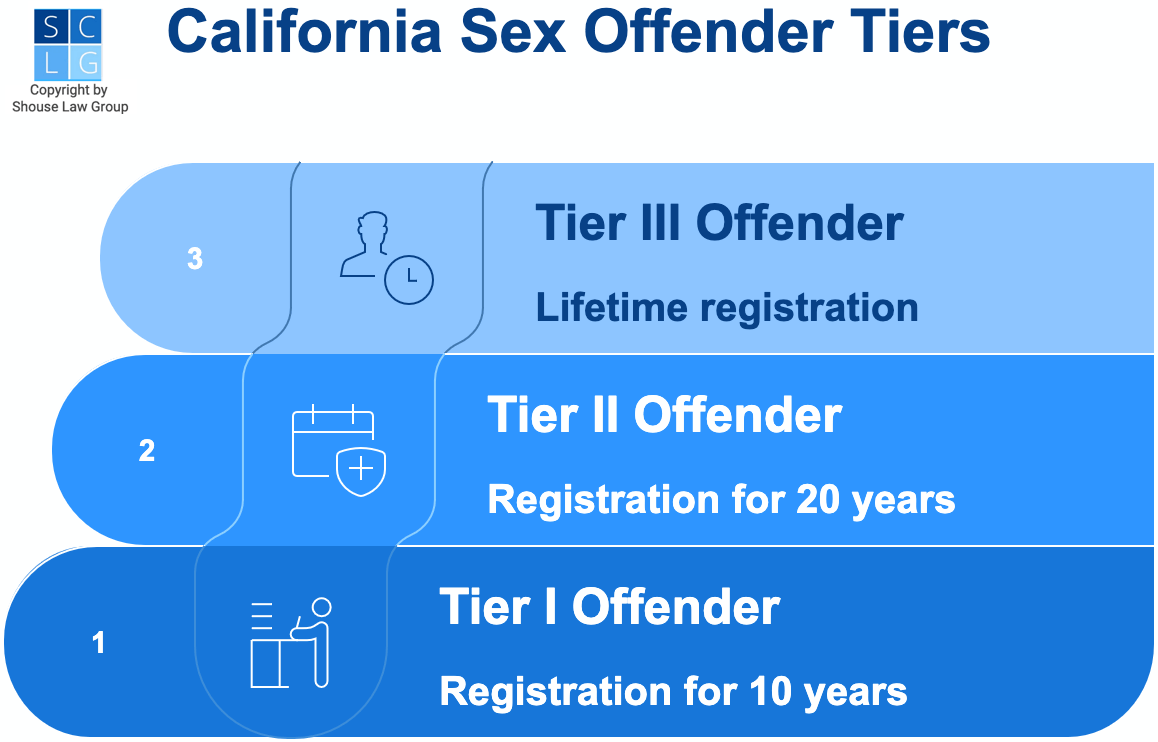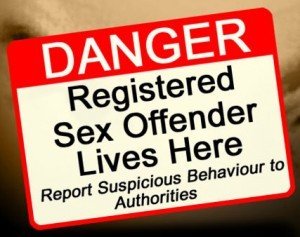Senate Bill 384 (SB 384) changed the sex offender registration process in California as of 2021. The legislation replaced mandatory lifetime registration for all sex offenses with three separate tiers based on the seriousness of the sex offense.

Also, juveniles are treated differently from adult offenders under SB 384. Plus, there may be registration complications if you move to or from California.
In this article our California criminal defense attorneys discuss the following topics re. sex registration:
- 1. The Three Tiers
- 2. Petition for Removal
- 3. Juvenile Offenders
- 4. Out-of-State Issues
- 5. Failing to Register
- Additional Resources
1. The Three Tiers
If you get convicted of certain California sex offenses, you get classified as Tier One, Two, or Three depending on the seriousness of the offense.1 These tiers are as follows:
- Tier One, which carries 10 years on the registry, is for low-level sex offenses like:
- misdemeanor sexual battery (243.4 PC)
- arranging to meet a minor for lewd purposes (288.4 PC)
- misdemeanor indecent exposure (314 PC)
- indecent exposure (314 PC)
- misdemeanor oral copulation (288a PC)
- enticing a child into house of prostitution (266 PC)
- inducing sex by fraud (266c PC)
- misdemeanor possession of child pornography (311.11 PC)
- first offense of annoying or molesting a child (647.6 PC)
- Tier Two, which requires 20 years on the registry, is for mid-level sex offenses like:
- rape of an adult 18 or older incapable of giving consent because of a mental disorder or disability (261 PC)
- incest (285 PC)
- lewd acts with a minor under 14 (288 PC)
- sodomy with a minor under 14 (286 PC)
- penetration with a foreign object when the victim is incapable of giving consent due to a mental disability (289 PC)
- contacting a minor to commit a felony (288.3 PC)
- second or subsequent offense of annoying or molesting a child (647.6 PC)
- Tier Three, which requires lifetime registration, is for severe sex crimes like:
- most other cases of rape (261 PC)
- spousal rape by use of force (262 PC)
- child human trafficking (266 PC)
- oral copulation by force (287 PC)
- sex trafficking of children (236.1 PC)
- sex acts against a child under the age of 10 (288.7 PC)
- felony child pornography (311.11 PC)
- murder committed in the attempted commission of rape (187 PC)
- kidnapping during commission of rape (207 PC and 209 PC)
- pimping with a minor (266h PC)
- pandering with a minor (266i PC)
- transporting minor under 16 for lewd purposes (266j PC)
- taking a minor away for prostitution (267 PC)
- assault with intent to commit a felony (220 PC)
- lewd acts with minor under 14 by force (288(b)(1) PC)
- lewd acts with a minor causing bodily harm (288(i) PC)
- sending harmful material to seduce a minor (288.2 PC)
- continuous sexual assault of a child (288.5 PC)
- sexual assault on a child under 10 (288.7 PC)
These registration time frames begin when you get released from incarceration or commitment. It gets tolled (paused) for any time you go back into custody.2

Getting removed from the California sex registry is not automatic. You need to petition the court.
Tier Criteria
The amendments to the Sex Offender Registration Act in SB 384 also set out the criteria for tier designation. While the specific sexual offense is an important factor, California courts also consider:
- the nature of the offense,
- the age and number of the victims,
- whether any victim was personally unknown to you at the time of the offense, or was known for less than 24 hours at the time of the offense,
- your criminal or relevant non-criminal behavior, both before and after the offense,
- whether you had a prior conviction or arrest for a sexually motivated offense,
- your current risk of a sexual offense or a violent offense (risk of recidivism), and
- your risk level under the State-Authorized Risk Assessment Tool for Sex Offenders (SARATSO) for static, dynamic, and violent risk assessments.3
Unlisted Crimes
If you have been convicted on charges not listed under the Act, judges can still order you to register as a sex offender if you committed the offense:
- out of sexual compulsion or
- for the purposes of sexual gratification.4
If you are ordered by a court to register for an unlisted crime, you are presumably a Tier One offender. However, the court may impose a higher tier if it makes specific findings that it is necessary for public safety.

By creating tiers for different offenses, SB 384 brings California in line with most other states in the U.S.
2. Petition for Removal
If you are a Tier One or Two offender, SB 384 allows you to file a petition to terminate registration once you finish the minimum mandatory registration period.
If successful, this petition can lead to you to being removed from the registry. Your personal information will also be removed from publicly available databases such as the “Megan’s Law website.”
It is important to note, though, that the registration durations for all of the tiers are minimum time periods. If you are a Tier One offender, you may end up re-registering every year for life if your petitions for removal get denied.
Note that California’s Clean Slate Laws (SB 731 and AB 1076) have no effect on sex registration and removal rules. They simply provide automatic clearing (“relief”) for non-serious, non-violent, and non-sex-related criminal records.
Filing the Petition
You must submit your petition to terminate registration requirements to the:
- applicable superior court or juvenile court,
- the registering law enforcement agency, and
- the county district attorney’s office (“prosecuting agency”).
The police have 60 days to report its recommendations to the D.A. The D.A. then has 60 days to ask for a hearing to contest the petition on the grounds that discontinuing registration would hurt public safety.
The petition can be filed on or after your first birthday following the expiration of your minimum registration period. The petition has to include proof of current registration.
If the judge rejects your petition for removal, the judge will let you know when you can reapply for removal from the registry. It can be no earlier than one year and no later than five years after the rejection.
Early Removal
If you are a Tier Two offender – which means you have to register for 20 years – you can petition for removal after just 10 years if:
- there was no more than one victim was aged 14 to 17,
- you were younger than 21 at the time of the crime,
- the offense was not a serious or violent felony, and
- you picked up no subsequent convictions.
If you are a Tier Three offender – which means you have to register for life – you may be able to get early removal if the sole reason for your tier level is a heightened Static-99R risk assessment.5

Before SB 384, law enforcement was spending most of its time on administrative tasks such as record-keeping and monitoring low-risk offenders.
3. Juvenile Offenders
Juveniles in California do not have to register as a sex offender for as long as adults do. A juvenile’s registration duration is:
- 5 years for Tier One offenders and
- 10 years for Tier Two offenders.6
If you were a juvenile (under 18) at the time of the sex offense – and the minimum registration period has passed – you can petition for removal from the registry with the juvenile court in the county in which you are registered.7
4. Out-of-State Issues
Not all sex crimes that are “registerable” in one state are “registerable” in another.
This means that if you no longer have to register as a sex offender in your state, you may have to resume registering if you move to California. This can also happen if you leave California for another state.8
Where there is no equivalent registrable offense in California, an out-of-state conviction will usually lead to Tier Two obligations if you move to California.9 However, it will become Tier Three if any of the following is true:
- your static risk assessment in SARATSO is well above average at the time of release, or
- you have been civilly committed to a mental health facility as a sexually violent predator, or
- you were subsequently convicted in a separate proceeding for a substantially similar offense as the one that led to registration requirements, or for an offense that is substantially similar to the California crimes of:

Failing to register as a sex offender is its own crime in California.
5. Failing to Register
As a sex offender in California, you have to register with local law enforcement every year. You also have to re-register every time you change addresses.
The failure to register as a sex offender is a felony if the underlying sex offense was a felony. Penalties include:
- 16 months, 2 years, or 3 years in state prison,
- up to $10,000 in fines, and
- formal probation.
Meanwhile, failing to register is a misdemeanor if the underlying offense was a misdemeanor. Penalties include:
- up to 1 year in county jail,
- up to $1,000 in fines, and
- summary probation.11
Failing to register as a sex offender also lengthens the minimum registration duration. The time period increases by:
- 1 year for every misdemeanor conviction of failure to register as a sex offender or
- 3 years for every felony conviction.12
It is not a defense that you had a good faith belief that SB 384 ended your registration obligations. The only thing that terminates your obligation to register is a court order granting a petition for the termination of registration requirements.

Tier III registrants are usually habitual offenders (under 667.71 PC), serving a life sentence and have a high-risk Static-99R score.
Additional Resources
If you are struggling with sexual impulses, consider getting help:
- Association for the Treatment of Sexual Abusers (ATSA)— ATSA offers referrals, programs and resources for those suffering from sexual compulsions and sexual disorders.
- Sex Addicts Anonymous (SAA) – 12-step program to overcome sex addiction.
- Substance Abuse and Mental Health Services Administration (SAMHSA) – 24/7 confidential helpline offering referrals.
- Sex Addiction – Article and guidance by AddictionHelp.org.
Legal References:
- California Penal Code 290(d) PC. California’s prior law requiring lifetime registration for all sex offenders began in 1947. California was the first U.S. state to impose such a law. (Florida and Alabama have similar laws. South Carolina now allows lifetime registrants an opportunity to be removed through judicial review.) The registration information goes into the CSAR database/repository (short for California Sex and Arson Registry). Law enforcement can access all the information in CSAR, but only some of it is accessible to the public through the Megan’s Law database. SB 384 was written by state senators Scott Wiener, Joel Anderson, Holly Mitchell, and Nancy Skinner in an effort to make the sex registration system more fair for lower-level offenders and to allow law enforcement more time to devote to monitoring higher-level offenders. See also AB 218.
- California Penal Code 290(e) PC.
- California Penal Code 290.006(c) PC.
- California Penal Code 290.006 PC.
- California Penal Code 290.5 PC. See, for example, People v. Hamilton (Cal.App. 2025) ; People v. Franco (Cal.App. 2024) .
- California Penal Code 290.008(d) PC.
- California Penal Code 290.008(d)(3) PC.
- California Penal Code 290 PC.
- California Penal Code 290(d)(4)(B) PC.
- Same.
- California Penal Code 290.018 PC.
- California Penal Code 290(e) PC.

